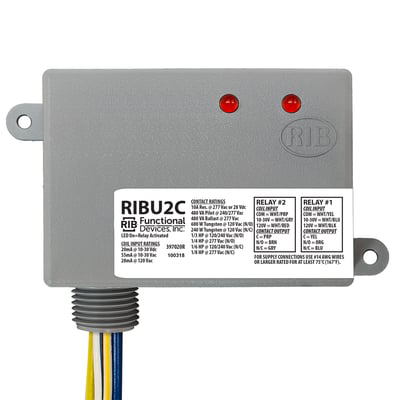ICP Furnace Showing 80% Limit Fault
Most gas furnaces have several safety limits, main limits, roll-outs, 80%’s will have a DSS (Daft Safety Switch) These safety

There are many capabilities and functions of RIB relays. The RIBU1C and the RIBU2C are two of the most common and user-friendly relays. Using 10-30 AC/DC voltage or 120V AC voltage, these relays can control one or two legs of power. They are commonly used to break 120V and 208/230V high-voltage power sources. These relays have normally closed (N/C) and normally open (N/O) contacts that change state when voltage is applied or removed.
Power is applied to the N/C set of contacts on the RIBU1C through the yellow and blue wires, with yellow serving as common and blue as N/C. The N/O set of contacts is controlled by the yellow and orange wires, with yellow as common and orange as N/O. If you have a RIBU2C, it contains two relays instead of one. The wire colors for the N/C and N/O sets of contacts for the first relay are the same as those of the RIBU1C, but they differ for the second relay. For relay two, the N/C set of contacts is controlled by the purple and gray wires, with purple as common and gray as N/C. The N/O set of contacts for relay two is controlled by the purple and brown wires, with purple as common and brown as N/O.
These relays are a simple solution for interlocking external pieces of equipment with various HVAC systems, such as interlocking a rooftop unit with a 120V exhaust fan. When the indoor fan on the rooftop unit is energized, the contacts on the RIB relay close, activating the exhaust fan. By utilizing C and R on the rooftop control board with the Wht/Yell and Wht/Blu wires on the RIB relay, along with the yellow and orange wires to break 120V for the exhaust fan using the N/O contacts, this process can be achieved effectively.
These relays are suitable for both commercial and residential applications. They are widely available at most major HVAC suppliers and are quick and easy to install.


Disclaimer: The technical statements, information and recommendations contained herein are believed to be accurate as of the date hereof, but Mingledorff’s does not make representations or warranties, express or implied, as to its accuracy, its completeness, or the results to be obtained. The information is being provided for informational purposes only and is intended for use by persons having adequate skill and expertise regarding the proper selection, use and application of the products and recommendations and at their own risk and discretion.
Most gas furnaces have several safety limits, main limits, roll-outs, 80%’s will have a DSS (Daft Safety Switch) These safety
This article is in reference to Residential Heat Pumps. Everyone in the HVAC industry knows that the indoor TXV
Compressors are the heart of the refrigeration system. It creates the pressure difference to move the refrigerant through the system.